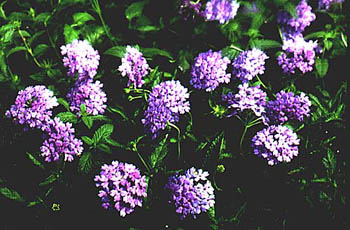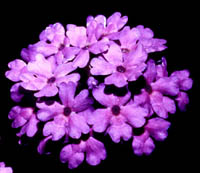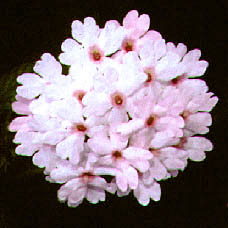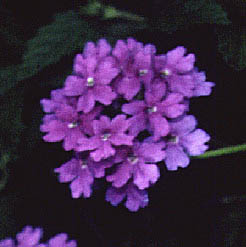VERBENA -- QUEEN OF SUMMER BEAUTY
 The search is endless for a plant which blooms profusely, tolerates heat
and endures from year to year. Throughout the years we always come back to one of
the showiest of perennial flowers -- the verbena. Verbena has many attributes such
as heat tolerance, everblooming and enduring. However, since nothing is perfect,
verbena has some faults which, if known in advance, can be avoided. Remembering
that "a word to the wise is sufficient", I will concentrate this article on the faults
of verbena so you can know how to successfully grow one of Texas' most adapted
plants.
The search is endless for a plant which blooms profusely, tolerates heat
and endures from year to year. Throughout the years we always come back to one of
the showiest of perennial flowers -- the verbena. Verbena has many attributes such
as heat tolerance, everblooming and enduring. However, since nothing is perfect,
verbena has some faults which, if known in advance, can be avoided. Remembering
that "a word to the wise is sufficient", I will concentrate this article on the faults
of verbena so you can know how to successfully grow one of Texas' most adapted
plants.The first, and probably most significant, Verbena problem is knowing how to identify the best of the Verbena types. In 1985 Extension horticulturists began to clarify Verbena nomenclature. Verbena types available are the short-lived annual verbena (Verbena hortensis); the large-flowered, short-lived perennial verbena (sometimes referred to the species V. x hybrida types); and the smaller-flowered but long-lived perennial verbena loosely referred to by botanists as Verbena Hybrids (Verbena x tenera). Throughout the years local horticulturists have noticed that a particular form of the last classification of Verbena Hybrids are among the easiest of the verbena to grow and would normally be perennial unless exposed to a wet spring or fall when the foliage is susceptible to attacks of the fungus called powdery mildew. To clearly identify this superior Verbena for garden consumers was a major problem. The adapted Verbena was called by many names such as common verbena (there were at least three types called verbena!), sand verbena and vervain. The most adapted Verbena did not have a common name which could be agreed upon by the numerous botanists consulted because this Verbena is a hybrid (mixture of species). Regardless of its true identity, all agree that it is a tough, Texas plant which should be planted in this area by those who enjoy beautiful bloom in the heat of summer. To plainly identify this Verbena, it was given the name TexTuf. TexTuf verbena is available in three colors -- purple, pink and red. The true TexTuf Verbena has a label in each group of plants clearly identifying it as the selected type. Otherwise, the buyer has to be familiar with the plant-type to know it is the long-lasting Verbena.
The second problem with Verbena is planting location and culture. Most people make the mistake of pampering it. It MUST be planted in the sunniest, best drained spot in your landscape. It WILL NOT bloom profusely, and, in fact, becomes diseased with powdery mildew unless the plants get plenty of sunlight (8-10 hours of direct, sunbathing sunlight). Verbenas do not require a particularly rich soil but periodic (at least monthly) applications of a slow-release, complete fertilizer such as 19-5-9 at the rate of one pound per 100 square feet are beneficial during the growing season. In the case of plants which have borne an abundance of bloom and then show signs of going out of bloom, a light pruning will produce another crop of flowers within 15-20 days. Here's the problem; people DO NOT want to cut plants back and WILL NOT cut them back as long as one pitiful-looking bloom endures. People who cannot discipline themselves to to shear old blooms periodically should not grow Verbena. After the first spectacular bloom display cut-shy people will be looking at ugly for the rest of the season and wondering why. Bloom removal is not tedious. Simply trim about a fourth of the plant's top growth, including old flowers but do not expose main stems, with a flexible line trimmer. Pruning removes old flower parts, shortens the plants and encourages branching which soon results in an even showier and prolonged display of bloom especially if you will fertilize and water after each cutback. Cutback will probably be required two or three times per season. The final, most drastic cutback will be in the fall when plants are cutback so winter annuals such as pansies, dianthus or bluebonnets can the interplanted among the Verbena.
The third problem with Verbena is that they are susceptible a few to pests. Well, so is every other living thing! I mentioned that Verbena is susceptible to the fungus powdery mildew if planted in a wet, shady locale. If the plant is neglected (not fertilized and watered properly) it is likely to become infested with spider mites, a common Texas nemesis. Miticides such as Kelthane (Red Spider Mite Spray) with two teaspoons of liquid detergent added per gallon of spray applied every 5 days for four consecutive sprays will help. Organic growers can use insecticidal soaps or sulfur dust but an invasion of spider mites MUST be dealt with or plants can be destroyed. Leaf miners which make little trails in the leaves do not cause significant damage but are ever-present. Systemic insecticides such as isotox, disyston (Systemic Insecticide), and cygon can be used periodically for longer lasting insect control. Thrips can also be a problem and can be controlled with the same insecticides.
The three problems which I mention, just to make you aware, SHOULD NOT distract gardeners from using one of the few summer perennials which can survive and beautify the Texas summers (which are usually hotter than Hades!)
Verbena is described as "a genus of perennial herbs (sometimes known by the ancient name Vervain)". Verbenas have been known since the most ancient times. The druids had the greatest veneration for the plant, and before gathering it offered a sacrifice to the soil. They also held bunches of verbena between their hands during their devotions. When the Romans sent messengers of peace to other nations they adorned their apparel with sprays of verbena. Images of Venus Victrix were often crowned with wreaths of verbena and myrtle. The peoples of Antiquity also attributed verbenas with certain medicinal properties. It was noted that much of the fame attached to the plants was mainly attributable to magical practices performed with the herbs. The Romans credited powers of rekindling the flames of dying love to the plant, and gave it the name Herba Veneris (plant of Venus). During the Middle Ages and the Renaissance, it became an instrumental component in the rites of witches and sorcerers. In folk medicine, a decoction of verbena leaves boiled in vinegar was used to treat rheumatic pains, lumbago, and pleurisy. It also provided a potion for aiding digestion. The flowering tips of young growth and the leaves of Verbena officinalis dried in the sun contain the glucoside verbenaline which, if incorrectly used, can cause paralysis. All of the Verbena which I have previously mentioned are crosses of several species and not intended for herbal use. I just though since some people enjoy saying they are growing "herbs", Verbena fits right into the herb category. Besides, Verbena is a beautiful blooming herb which will tolerate all that a hot Texas summer has to offer.
Blue Princess
 Verbena X hybrida 'Blue Princess'
Verbena X hybrida 'Blue Princess'
Hardiness: Zone 7
Foliage: Evergreen
Exposure: Full Sun
Water: Medium
Habit: Vigorous, spreading plant 12
inches (30)cm tall and 4 feet (120 cm)
wide.
Uses: Bedding plant, containers,
baskets, perennial border, butterfly and
hummingbird garden.
Rose Princess
 Verbena X hybrida'Rose Princess'
Verbena X hybrida'Rose Princess'
Hardiness: Zone 7
Foliage: Evergreen
Exposure: Full Sun
Water: Medium
Habit: Vigorous, spreading plant 12
inches (30) cm tall and 4 feet (120 cm)
wide.
Uses: Bedding plant, containers,
baskets, perennial border, butterfly and
hummingbird garden.
Purple Princess
 Verbena X hybrida'Purple Princess'
Verbena X hybrida'Purple Princess'
Hardiness: Zone 7
Foliage: Evergreen
Exposure: Full Sun
Water: Medium
Habit: Vigorous, spreading plant 12
inches (30) cm tall and 4 feet (120 cm)
wide.
Uses: Bedding plant, containers,
baskets, perennial border, butterfly and
hummingbird garden.
White Princess
Verbena X hybrida'White Princess'
Hardiness: Zone 7
Foliage: Evergreen
Exposure: Full Sun
Water: Medium
Habit: Vigorous, spreading plant 12
inches (30) cm tall and 4 feet (120 cm)
wide.
Uses: Bedding plant, containers,
baskets, perennial border, butterfly and
hummingbird garden.
Pinwheel Princess
Verbena X hybrida'Pinwheel Princess'
Hardiness: Zone 7
Foliage: Evergreen
Exposure: Full Sun
Water: Medium
Habit: Vigorous, spreading plant 12
inches (30) cm tall and 4 feet (120 cm)
wide.
Uses: Bedding plant, containers,
baskets, perennial border, butterfly and
hummingbird garden.
Sources:
Mail Order: Loco Valley Plant Farm, Rt. 8, Box 3386-B, Nacogdoches, Texas 75964. 409-715-9468.
Horticulturally, 1995 was a good year. That was the year I brought Blue Princess Verbena back from England. I picked it up at Wisley, the fabulous gardens of the Royal Horticultural Society. They have one of the greatest nurseries in the world with an amazing selection of both woody and herbaceous plants. Although most plants that thrive in the English climate parch in ours, there are certain universal plants to be had. I didn't purchase Blue Princess verbena because I liked the flower color or its delicate fragrance. As a matter of fact, it wasn't even blooming. The only reason I brought it back was because it was one that I hadn't heard of or grown before.
As Director of Research and Development at the time for Lone Star Growers in San Antonio, it was my job to evaluate potential new introductions and improvements for the nursery. I just happened to be in the middle of a large verbena trial at the time. Up until those trials, the only verbenas that we produced were what was known as the Tex Tuff Verbenas, an old cutleaf hybrid that came in red, pink, and purple.
After several years of trialing nearly fifty perennial type verbenas, Lone Star added Homestead Purple, Summer Blaze, Abbeville, Fiesta, Texas Appleblossom, and Pink Sunrise, to their perennial line.
That was the very year I showed up with Blue Princess, which hadn't previously been grown in the U.S. It didn't take her long to prove to be one of the most vigorous verbenas in the trial. In addition to having clean mildew resistant foliage, Blue Princess showed improved heat tolerance as well as improved cold tolerance over the other cultivars.
Blue Princess verbena went on to become a successful 1998 Texas SuperStar in Texas A&M's wonderful CEMAP program.
But that wasn't the end of the Blue Princess legacy. Several years ago while wandering through my new home at the Stephen F. Austin University Arboretum, I happened to notice a single flower cluster that had lavender and white striped flowers instead of the usual lavender-blue. After several rounds of cuttings, the new striped form proved to be stable with all the desirable characteristics of Blue Princess. Due to the striped flowers, I named it Pinwheel Princess. That same year, Matt Welch, an SFA graduate found the exact same sport in a North Carolina garden. Matt is now our arboretum technician. We couldn't let another state claim one of our prize graduates! Especially one with a good eye for plants.
Sports are accidental shoots on a plant that are different in some aspect from the original plants. Other chance sports that come to mind are red grapefruit, delicious type apples, and many climbing roses. Keep your eyes open. You might just find one for yourself.
Despite the fact that the flower color of Pinwheel Princess is mostly stable, I later found an all white sport that I'll be introducing this year as Ice Princess verbena. Unlike seedlings that don't necessarily have the same characteristics as their parents, sports are often identical in their other characters. That means we get the same tough plant with a different flower color.
In addition to these chance sports, there will soon be a series of Blue Princess seedling offspring available as well, in shades of pink, purple, lavender, and white. Where will it end? Not in England, that's for sure!
Verbena in the summer used to be a rare site in Texas. Now along with Blue Princess, Pinwheel Princess has earned her stripes as well.
Greg Grant teaches horticulture at Stephen F. Austin University in Nacogdoches.